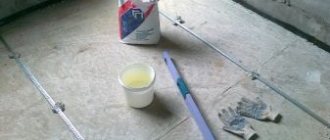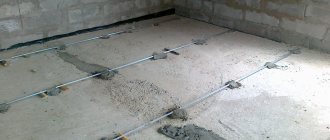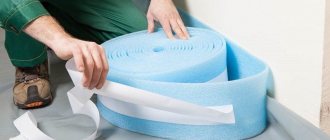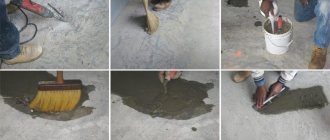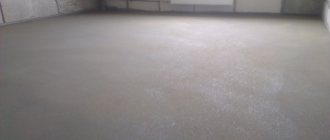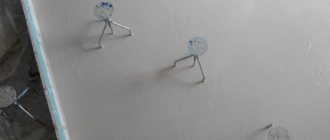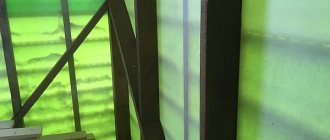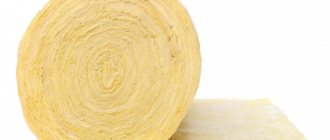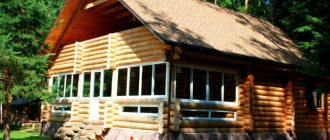Concrete for semi-dry screed has a low water-cement ratio, and therefore has poor workability. The technology was originally intended for mechanized work at all stages. However, renting special equipment is not always economically beneficial for the developer. Therefore, it is practiced to install semi-dry floor screed manually. In this case, a ready-made CPS mixture is purchased (cement-sand, proportion 1/3, respectively), only trowels are used, which are impossible to do without.
This article will discuss this particular method of semi-dry concrete screed for interior spaces.
general information
In the process of making semi-dry screeds, dry ready-made mixtures have become more often used, which make the work easier and more convenient. A mesh made of steel material or fiberglass is selected as a reinforcing substance. To reduce the load on the floor and improve the strength characteristics, purchase fiberglass.
The concrete mixture dries much faster due to the small amount of water. The average period is 5-6 days. These figures are approximately 5 times faster than pouring a “wet” screed.
The semi-dry version of the subfloor installation can be done both on concrete floor slabs and on a wooden base. The room where the installation is carried out, as well as the subsequent floor covering, will not play a role. The main thing is that the technology is followed at all stages.
It is worth noting that the thickness of the semi-dry screed is determined very carefully. The height of the finished cake is influenced by certain factors.
Factors affecting thickness
There are certain conditions that affect the thickness of the floor screed. This is not only the technology itself, but also:
- Characteristics of the operation of the room where work on the construction of the subfloor is carried out. The greatest loads on the floor are in the corridors, kitchen and living room. So you should not think about the minimum indicators in such premises, but do a little more than required.
- Floor covering that will be laid after the prepared base has dried.
- The material into which the semi-dry screed is poured, as well as the very condition of this coating. The more unevenness there is, the more it will be necessary to arrange a layer of semi-dry screed. If you pay attention to building codes and regulations, then the minimum thickness is set at 20 mm. With such a thin layer, it is very important to think about reinforcement so that it does not crack over time.
- Materials for semi-dry floor screed used in the process.
Each of these factors adds or decreases the overall thickness and creates conditions for the use of additional moments in installation. But this does not mean that a very thin or very thick base will be more effective, unlike each other. At the same time, there are subtleties and nuances. Each specific case should be approached individually.
Semi-dry screed technology with minimal thickness
The technology for making semi-dry screed with a minimum layer thickness has some distinctive features. First of all, it should be taken into account that mixtures for semi-dry screed contain a minimum of water, which ensures that the solution hardens quickly.
With a minimal layer of screed, the solution may harden before it adheres to the base of the subfloor. As a result, such a screed will quickly dry out and crumble under the influence of physical stress. To avoid cracking of the dried semi-dry screed, fiber fiber is added to the prepared semi-dry mixture.
This option for strengthening the screed is less expensive, both in material and labor-intensive terms, than reinforcing the base layer of the floor.
For high-quality and long-term floor screeding with semi-dry mixtures, it is necessary to carefully prepare the surface on which the screed will be performed.
To do this, it is necessary to remove the exfoliated sections of the subfloor and fill the resulting voids with cement mortar. The cracks must be widened and filled with cement. Knock off obvious protrusions with a hammer.
The base of the floor is thoroughly cleaned of debris and dust.
Then the mixture for semi-dry floor screed is distributed onto the clean surface of the base. The mixture includes:
- Cement grade M500.
- Sand.
- Water.
- Forming fiber.
- Plasticizer.
The laid mixture is carefully leveled and sanded.
After 10-12 hours you can already walk on such a surface, and after a week the finishing coating is laid on the floor.
Even with the minimum thickness of the screed, the floor is strong and durable, with guaranteed high heat and sound insulation. When completely dry, such a screed does not deform and forms a smooth surface that does not require additional leveling with liquid mixtures.
This screed does not crack due to the minimal amount of liquid and the presence of fiber fiber in its composition.
For better adhesion of the semi-dry screed to the base, it is necessary to use an underlying layer of polyethylene film. The thickness of the screed for this type of work should be at least 40 mm.
When performing a semi-dry screed, one should not forget about the need to lay a damper tape, the physical properties of which compensate for the expansion of the screed when drying. The tape is laid along the walls, along the entire perimeter of the room, with a height slightly higher than the level of the screed.
To achieve a high-quality result when performing a semi-dry floor screed, it is necessary to take into account the material on which the screed will be applied.
For penoplex
Penoplex is used as insulation under floor screed. Due to its composition, it does not allow moisture to pass through, thereby preventing heat loss in the room.
It is laid on the subfloor, all joints between the sheets are glued together, irregularities and holes are carefully repaired. The material is covered with waterproofing on top to prevent moisture from entering the cracks between the foam boards.
Semi-dry screed is applied to penoplex with a minimum layer thickness of 20 mm. But do not forget that this thickness of the screed is permissible only in rooms with permissible loads. The screed must completely ensure the hardness and density of the floor and not collapse under the influence of loads.
If additional loads are provided in the room, then a semi-dry screed should be performed after laying the reinforced mesh on the penoplex. The presence of reinforced mesh will additionally increase the permissible load on the screed. In this case, the minimum thickness of the screed must be at least 50 mm.
Semi-dry screed on Schumanet
For better sound insulation in the room, use sound insulation of the floor under the screed. Among the huge selection of soundproofing materials, Shumanet, made from bitumen and fiberglass, is very popular. The material insulates vibration noise well and has high waterproofing properties.
The optimal thickness of semi-dry screed on Schumanet is 60 mm, which can significantly reduce the height of the room. When applying a semi-dry screed, a prerequisite is the use of reinforced mesh.
Materials used
When you don’t want to mix the solution for semi-dry screed yourself, you should think about purchasing ready-made options. Dry building mixtures already contain all the necessary components to obtain the desired result. They include:
- Sand.
- Cement.
- Fiber fiber.
- Plasticizer.
It is worth noting that semi-dry screed with fiber fiber has much better qualities, which makes it easier to use when installing steel mesh. It gives the solution plasticity, which allows it to be evenly leveled over the surface of the prepared base. In addition, the end result is a smooth subfloor with high strength properties.
The brand of semi-dry screed will directly depend on the brand of cement used in the composition. The higher this indicator, the better the strength will be in the end. In this case, the semi-dry screed will turn out to be really strong and reliable. As the brand increases, the cost of the finished mixture for preparing the solution will also increase slightly.
Sand is selected from construction or river sand. Its fraction should not exceed five millimeters. You should carefully monitor the humidity, since the amount of water added to the solution will depend on it.
Plasticizing substances are included in the semi-dry floor screed and the composition of the mixture is externally no different. But the quality of the finished solution is high. When it is prepared independently, the plasticizer can be purchased separately, adding a certain amount depending on the volume. Plasticizer can be found at any hardware store.
Another advantage is that semi-dry floor screed with a ready-made mixture is much faster. In addition, you don’t have to think about proportions, which are very important in this case.
Types of screeds, their properties and features
Any violation of the execution technology will reduce the performance of the screed. It is extremely important to monitor the deviation of the floor level; if this figure exceeds 0.2%, then the finishing coating will not lie perfectly.
When arranging the screed, it is important to maintain the level
If the surface is not leveled thoroughly enough, gaps may appear between the laminate sheets. And I really don’t want to talk about such terrible cases when illiterate workers pour cement onto the floor and pour water on top. Messages about such disgrace can be found on specialized forums. A liquid screed made incorrectly begins to crumble and will never be a reliable basis for any finishing coating.
Incorrectly filled screed may crack.
Such a screed must be removed with a hammer drill and a chipper, taken out of the premises and a new screed made. The work of unskilled workers guarantees you additional time and money. It is much better to do the floor screed yourself, observing all the nuances and subtleties. It is especially important to observe the recommended thickness of the screed.
To ensure that the screed is even and strong, maintain the recommended thickness
Surface reinforcement
When a semi-dry floor screed is performed, the thickness will depend, among other things, on the reinforcing layer. In this case, everything familiar is a steel mesh with a cell size of 10*10 mm. But this begins to go away due to the increase in the weight of the finished structure on the floor.
A semi-dry screed with fiber comes as a replacement. This component is easily “introduced” into all components of the mixture and a single whole is obtained. The coating ultimately becomes more durable, stronger and harder, able to withstand any load and flooring without exception.
The steel mesh also increases the overall thickness of the subfloor. The installation process will look somewhat drawn out due to the creation of additional stages of work: filling the mixture, laying the reinforcing element, finishing work. With fiberglass everything is much simpler and more convenient.
Thickness selection
First, you should inspect the base of the subfloor itself. We will proceed from this when determining the thickness of the semi-dry screed. It will be enough to carefully examine the exterior. It’s a good idea to run a metal strip about a meter long. It will indicate existing uneven parts, as well as significant protrusions. Such defects appear not only in old buildings, but also in newly built houses. The precision of the work will allow you to perform the laser level.
Calculation of the thickness of semi-dry screed
Cement semi-dry floor screed begins with the preparation of the base. The smoother the surface, the less amount of solution will have to be spent during work.
Average expenses
The average cost of a screed made mechanically depends on the materials used and the soundproofing layer :
regular semi-dry will cost 500 rubles/m2 with a thickness of 60 mm;- with a layer of expanded clay (final thickness 8 mm) – 650 r/m2;
- when using polystyrene foam, the final thickness will be 9-12 cm, and the cost will be 750-850 RUR/m2.
Read more about the cost of semi-dry screed here.
The need to determine the minimum
The minimum thickness of a semi-dry screed should be determined in the case where there are installed communications or a heated floor system. By making a very large layer of subfloor, the distance from the floor to the ceiling is reduced. This is especially noticeable in low rooms.
Above the heated floor level, the minimum thickness should be 35 mm. This level is established immediately after the completion of all its elements. A thick floor increases the cost of heating the room, since the screed itself is saturated with heat for a long time, not to mention another obstacle - the floor covering.
The large thickness of the floor puts pressure on the ceiling. It appears most often on balconies. And the drying time will immediately increase. The material tends to expand over time. This can subsequently cause pressure on the walls if the layer is too massive.
If the mixture does not include any additional reinforcing substances, then its minimum thickness should be 40-50 mm. You can tell a lot about thickness by looking at the packaging for the mixture. Recommended parameters are always displayed there. Manufacturers always worry about the bottom line.
According to SNiP, when laying a semi-dry screed immediately on the floor slab, it must be at least 20 mm thick. If there is an additional layer of waterproofing - 40 mm.
Advantages and disadvantages
The positive qualities of semi-dry screed include:
- high strength while complying with all standards;
- after grouting, a smooth surface is obtained, since there are no voids after the water dries;
- durability more than 30 years;
- rapid drying, as well as acceleration of the start of troweling and laying the final coating;
- protection against water leakage when the floor is flooded;
- fast installation work;
- little shrinkage;
- can be combined with heated floors and communications.
Among the disadvantages it should be noted:
- the need for special equipment and the availability of experienced specialists;
- you need to carefully monitor the amount of moisture in the solution;
- the need for special sand, since ordinary river sand is not suitable;
- it is required to continuously lay the solution and level it, as it dries quickly;
- reduction in sound insulation if there is no special layer under the screed. If it is, then the soundproofing properties of the screed increase, which is why it itself becomes an insulator.
A detailed analysis of the pros and cons in this article.
